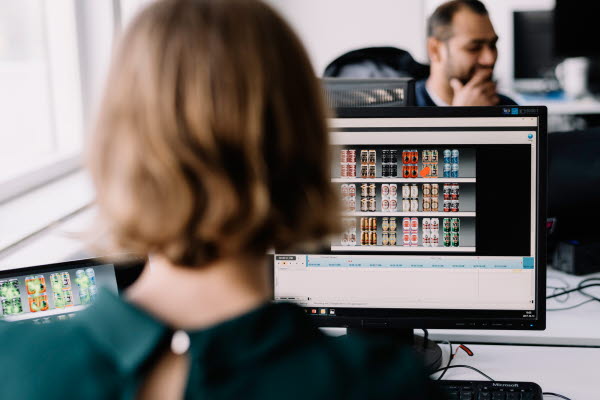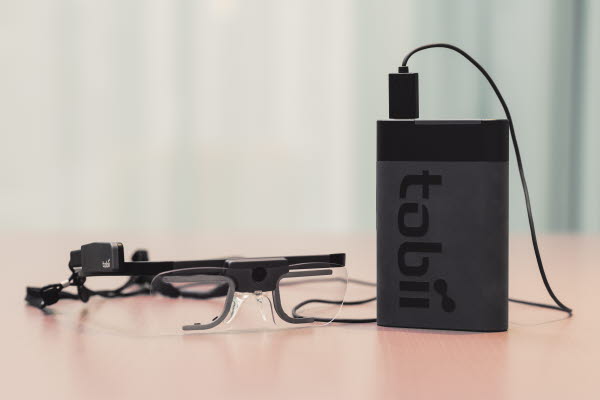The importance of packaging design to purchasing decisions has been debated for almost a century. The problem with traditional marketing surveys, as advertising guru David Ogilvy is claimed to have said, is that people don’t think how they feel, don’t say what they think and don’t do as they say. Our decisions are based largely on subconscious processes that we can’t detect. But what if we could find a back door into the subconscious?
The Swedish company Tobii is a global leader in the development of technology for reading and interpreting eye movements: eye tracking. The company was founded in 2001 and today it has almost 1,200 employees in 11 countries and annual sales of over 130 million euros. At first, the focus lay on developing hardware and software but over time the application of the technology has become increasingly important. The business unit Tobii Pro focuses on using technology to understand human behaviour and performs market surveys for customers like Unilever, Coca-Cola, Oriflame and Facebook.

We met with Ali Farokhian, Vice President of Marketing research and User experience at Tobii Pro.
“What’s important in studies of packaging design is to understand what we invest time in,” he says.
“What do we fixate on? Does our gaze return to the packaging? Is it relevant to me as a consumer or am I using my autopilot when I’m looking?”
For brand owners, it is important that their packaging design interrupts this autopilot. But it must be done in a way that agrees with the values that the customer associates with the product or the risk that it is not experienced as relevant. Another risk is that the design contains too many or too mutually contradictory elements that confuse the customer.
“Developing packaging can be an expensive process,” Ali says. “A lot can be gained if the customer finds the right product quickly.
“Eye tracking helps us to do studies at a very early stage of the design process, for instance by getting the study participants to look at pictures of various versions of the same packaging. Which icons do the customers look at in a specific product category? What message emerges from the design? How can we categorise such qualities as premium? By using eye tracking we can test both the packaging itself and the categorisation of what the packaging is supposed to communicate.”

When the brand owner has reached the point of having existing prototypes, it is time to do studies in the retail environment. The first aspect to be considered is the packaging’s ability to stand out: its prominence or in technical terms its “saliency”. This might involve strong colours and contrasts. This stage of the consumer’s gaze is called “preattention”. Then the consumer starts to place the packaging in relation to his or her own self and needs. This is when a purchasing decision begins to be made.
“What we see depends very much on who we are. But some things are universal,” Ali says.
“Faces attract our attention. We are drawn to other humans and seek eye contact because we are social beings. Strong colours and contrasts also attract everyone’s attention. But eye-catching elements can also ruin a packaging design.”
The quality of the results of a study depends on how well it is designed. There must be a clearly formulated purpose. The participants must be given a specific task connected to the product properties that the packaging must communicate, such as choosing a refreshing drink or a luxurious bar of chocolate. Ali says that sometimes the results are surprising.
“We did a study of packaging for sanitary napkins where the task was to choose the product that was the best value for money. In interviews afterwards, the participants said they had looked at the price. But in the images, we could see they had actually not done so. Instead, they had looked at a blue colour on one of the products and in some way associated that blue colour with the low-price category.”

This tool is frequently used in Tobii's studies to track eye movements.
One way to extract more results from studies involving eye tracking is to combine them with measuring the participants’ emotional reactions with the aid of electrodermal activity (EDA) technology, which measures the skin’s ability to conduct electricity. This lets us study how visual impressions cause emotional responses. By extension, we can learn more about which colours and symbols create a desired response in a specific context.
“How do I expect that this drink’s refreshing taste will be manifested in the packaging?” Ali asks. “It’s about how well the packaging conveys the values that the brand owner wants to communicate.”
Created 18 February, 2018.


